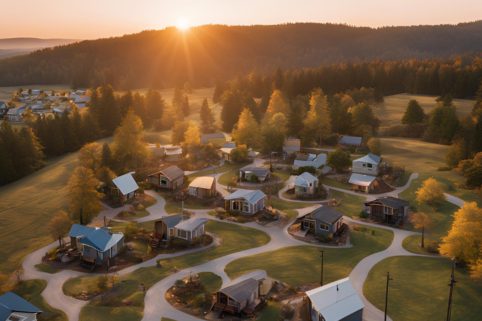Questions to Ask Before Starting a Supportive Housing Ministry
 AVERY WEST
AVERY WEST
Member Engagement Director
Read more from Avery
Listen to this article:
Skilled, compassionate ministry leaders want to walk those in crisis through relief, rehabilitation, and development to a flourishing life. For those facing mental or physical disabilities, that may not mean total self-sufficiency.
The folks at Eden Village in Wilmington, North Carolina understand that. Last fall, I visited them with my family and discovered how their skill and compassion enables individuals in their care to retain the dignity of home ownership and meaningful relationships in a safe, supportive community. We walked through the light-filled community center, along sidewalks connecting 31 homes, and out to the community garden. We were welcomed by residents sitting on their porches, friendly interns and volunteers, and the founding couple, Tom and Kim Dalton.
It was easy to see Eden values relationships. Tom is quick to credit Kim for its palpable culture of love and warmth, pointing to her as he introduced the staff and saying, “And this is the reason everyone loves it here!”
That stands in contrast to groups and municipalities around the country that understand the need for dignified housing but believe the solution lies in just providing a building (be it a tiny home or repurposed shipping container). Yet Eden Village demonstrates community, work and meaning (not building types) are the keys to a flourishing life.
Before you consider starting a similar community, it is important to understand the difference in types of homelessness and to assess if there is truly a struggle with chronic homelessness in your area.
The majority of homeless people are without housing for less than a year. Some are homeless for less than 2 weeks (referred to as “episodic homelessness”), and a quick stay with family or in an emergency shelter can help them get back on track. Others, who are homeless for up to a year (i.e., “transitional homelessness”) can benefit from a longer transitional housing program before living independently.
Those on the streets for more than a year, though, often have deeper struggles that prevent them from living on their own. Eden Village and similar permanent housing ministries serve this group of people, considered the “chronically homeless.” Residents in that situation typically combat intense mental illness, substance abuse, or physical disability; as well as a catastrophic loss of family, church and community connection. Tom shares, “Even if they didn’t experience trauma before becoming homeless, the trauma they experience living on the streets for over a year is difficult to overcome.”
In the relief, rehabilitation, development framework, the goal is to help people move from a place of just receiving to a place of mutual giving and receiving where they flourish by using their God-given gifts. In most cases, that means living on their own and providing for their family while still living interdependently with others. For instance, my husband and I have an established, functional home. Yet I still ask my sister-in-law to watch my kids while I go to a doctor’s appointment; and I bring church members meals when they are sick or have a new baby. We are meant to exist in a community of giving and receiving.
For the chronically homeless, that interdependence looks a little different. Yes, it’s likely they are incapable of living in an unsubsidized way. But they can still work full or part-time jobs, take part in local events, and make their neighborhood beautiful. It is that kind of holistic, relationship-based community Eden Village wants to create.
 Can you visit and learn from an existing community?
Can you visit and learn from an existing community?
Tom overflows with gratitude for the original Eden Village in Springfield, MO, which helps people like the Daltons start campuses all over the United States by providing policies, legal paperwork, and advice. They also host a conference in Springfield that Tom suggests any prospective permanent housing ministry attend. And he and Kim welcome True Charity members to visit the Wilmington Village at any time. After putting the Eden Village framework in place, they included (and continue to use) True Charity’s training and day-to-day programming resources to ensure their residents’ dignity.
 Do you have the right land?
Do you have the right land?
“Finding land is the toughest part,” Tom says. He cautions against rezoning or asking for a single variance. He learned, “When you ask for a variance, there is a hearing, and when there is a hearing, you lose every time.” Tom learned from the original Eden Village that to avoid local residents invoking their NIMBY rights (“Not in my Backyard”), you must follow every single rule. “You might find what you think is the perfect piece of land, but it would have to be rezoned, and you just have to move on. That’s heartbreaking … Once we found our land, we basically let our city planner plan the village,” Tom says. Initially, neighbors were hesitant because the property is in a residential area but “We put houses where he said to put them and we only built the number of houses he said we could build.” Once the neighbors saw the ministry was safe and beautiful, they embraced it as a welcome addition to the neighborhood.
An ideal property should have the following features:
- Close proximity to a bus stop and store because many residents don’t drive.
- Enough room for 20-30 houses, a community center, and green space. At 10 houses per acre, that’s three to four acres.
- Existing infrastructure. Vacant mobile home plots often work well because they are zoned correctly and already have water and utilities, which greatly reduces upfront costs.
 Can you find adequately equipped homes?
Can you find adequately equipped homes?
As mentioned, the goal of permanent housing is to preserve dignity and ownership for an individual or family unable to live on their own. With that in mind, potential homes should at least have a kitchen, bathroom, and bedroom. Tom also shares that buying houses with front porches helped them form a culture of friendship because neighbors love to sit on their porches and chat. And since they’re on the North Carolina coast, Tom made sure they were rated for hurricanes. Because Eden Village Wilmington is on a residentially-zoned property, they chose small modular homes. Communities built on mobile home lots often use park-model homes.
Eden Village wants their neighborhood to be a true community where people feel loved, volunteer, and are content to live out their lives. That’s why they limit its size to 30 houses. If your organization needs room for more homes, keep in mind it’s possible to build multiple villages on the same property adjoining one community center. As long as each group of 20-30 houses is fenced in and has their own sense of culture, the ministry can grow beyond one village. The fence, Tom shares, is crucial because it helps people who have experienced so much trauma feel safe. It also helps the staff monitor people coming in and out of the community so no drugs or weapons make their way in.
 Are you trying to meet every need?
Are you trying to meet every need?
Many people refer to this model as, “permanent supportive housing,” but Tom pushes back on “supportive.” He points out that while Eden Village does have a community store, case management, and events to help residents form deeper relationships, they don’t pretend to have everything someone needs. Their residents still work, grocery shop, go to the doctor, and attend church outside the village. In Tom’s mind, that’s a good thing. In other words, residents have their own loving community but are still part of the larger Wilmington ecosystem.
 Can you raise the funds?
Can you raise the funds?
Eden Village Wilmington cost about $5 million to build (though 3D concrete printing technology might bring that number down to $4 million for your organization). With 31 houses and two employees, they operate on a $500,000 annual budget, of which $120,000 is provided through rent. Building costs for each house was about $80,000 and monthly operational expense is $1,300 per residence.
The Daltons raised the initial money needed through a variety of means including a large federal home loan bank grant (a privately funded institution, despite the name); and generous families, foundations and churches foundations and churches who, for a price-matched contribution of $40,000, have the opportunity to name the home. Because houses are pre-built, the Daltons were able to “drop a house” on a foundation just three weeks after a donor sponsors one.
Tom’s biggest piece of fundraising advice? Put a house on the property as soon as possible. “You can meet with a potential donor in a Starbucks and try to show them your vision with powerpoint,” he says, “Or you can meet with them inside a beautiful tiny home and show them the joy and dignity that is possible.”
Building a village of permanent housing for struggling folks is not an easy, short-term undertaking. At Eden Village Wilmington, the work has been hard, stressful, and heartbreaking at times. But Tom assures leaders considering this ministry, “Whatever energy you put into it will come back to you tenfold. It’s the most humbling personal faith journey to tell someone, ‘This house is yours forever’ and watch them heal. It has changed the Dalton household.”
Tom and the Eden Village team would love to connect with you! True Charity Network members can reach out through the members’ directory.




